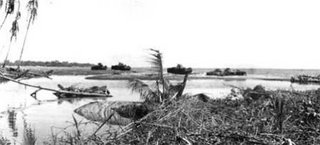 Five Japanese tanks sit dead in the water, destroyed by Marine 37mm gunfire during the abortive attempt to force the Marine perimeter near the mouth of the Matanikau River in late October. Many Japanese soldiers lost their lives also.
Five Japanese tanks sit dead in the water, destroyed by Marine 37mm gunfire during the abortive attempt to force the Marine perimeter near the mouth of the Matanikau River in late October. Many Japanese soldiers lost their lives also. Marine Corps Personal Papers Collection
******
With daylight, Puller and Hall reordered the lines, putting the 3d Battalion, 164th, into its own positions on Puller's left, tying in with the rest of the Army regiment. The driving rains had turned Fighter One into a quagmire, effectively grounding Cactus flyers. Japanese planes used the "free ride" to bomb Marine positions. Their artillery fired incessantly and a pair of Japanese destroyers added their gunfire to the bombardment until they got too close to the shore and the 3d Defense Battalion's 5-inch guns drove them off. As the sun bore down, the runways dried and afternoon enemy attacks were met by Cactus fighters, who downed 22 Japanese planes with a loss of three of their own.
As night came on again, Maruyama tried more of the same, with the same result. The Army-Marine lines held and the Japanese were cut down in droves by rifle, machine gun, mortar, 37mm, and artillery fire. To the west, an enemy battalion mounted three determined attacks against the positions held by Lieutenant Colonel Herman H. Hanneken's 2d Battalion, 7th Marines, thinly tied in with Puller's battalion on the left and the 3d Battalion, 7th Marines, on the right. The enemy finally penetrated the positions held by Company F, but a counterattack led by Major Odell M. Conoley, the battalion's executive officer, drove off the Japanese. Again at daylight the American positions were secure and the enemy had retreated. They would not come back; the grand Japanese offensive of the Sendai Division was over.
About 3,500 enemy troops had died during the attacks. General Maruyama's proud boast that he "would exterminate the enemy around the airfield in one blow" proved an empty one. What was left of his force now straggled back over the Maruyama Trail, losing, as had the Kawaguchi force in the same situation, most of its seriously wounded men. The Americans, Marines and soldiers together, probably lost 300 men killed and wounded; existing records are sketchy and incomplete. One result of the battle, however, was a warm welcome to the 164th Infantry from the 1st Marine Division. Vandegrift particularly commended Lieutenant Colonel Hall's battalion, stating the "division was proud to have serving with it another unit which had stood the test of battle." And Colonel Cates sent a message to the 164th's Colonel Bryant Moore saying that the 1st Marines "were proud to serve with a unit such as yours."
Amidst all the heroics of the two nights' fighting there were many men who were singled out for recognition and an equally large number who performed great deeds that were never recognized. Two men stood out above all others, and on succeeding nights, Sergeant John Basilone of the 1st Battalion, 7th Marines, and Platoon Sergeant Mitchell Paige of the 2d Battalion, both machine gun section heads, were recognized as having performed "above and beyond the call of duty" in the inspiring words of their Medal of Honor citations.
This series will begin next time with the November battles.
No comments:
Post a Comment